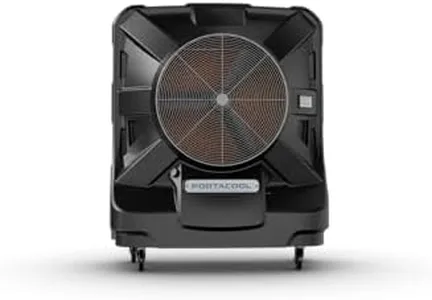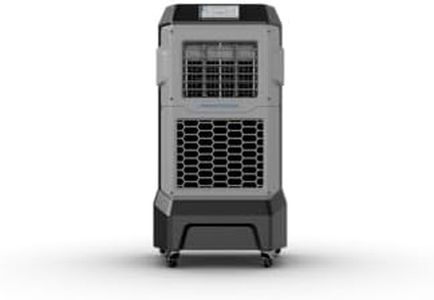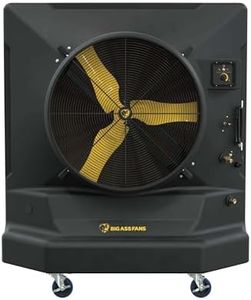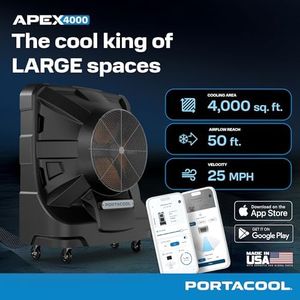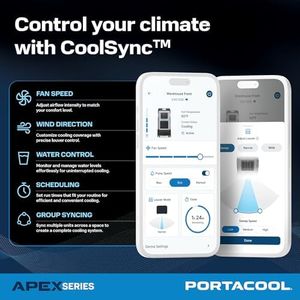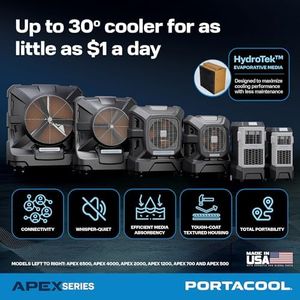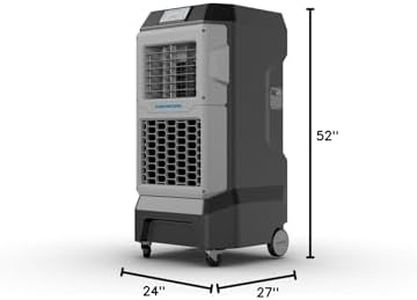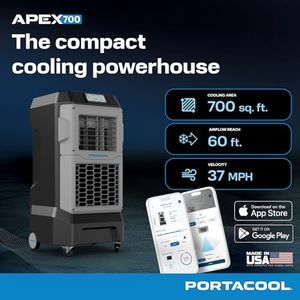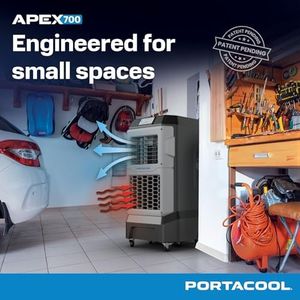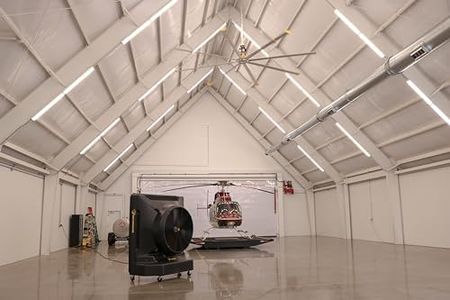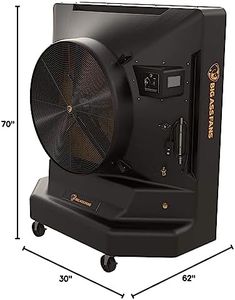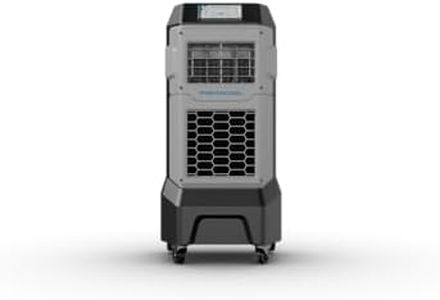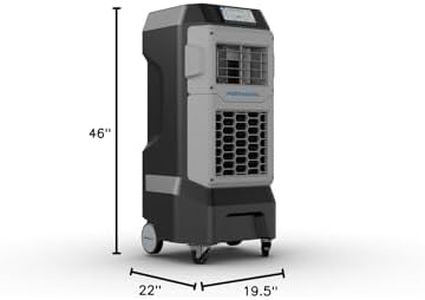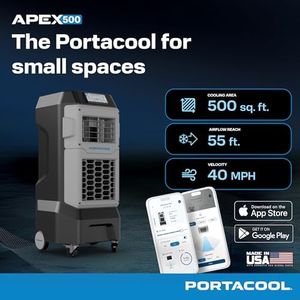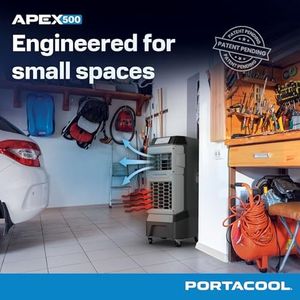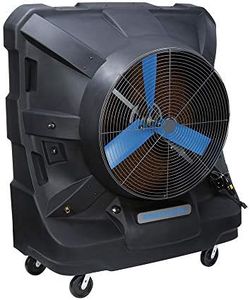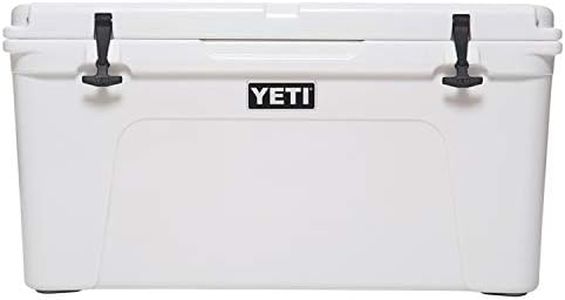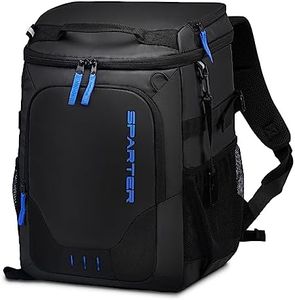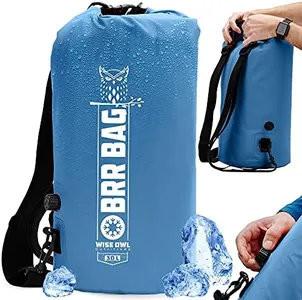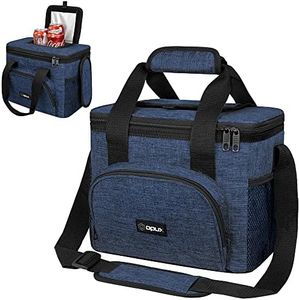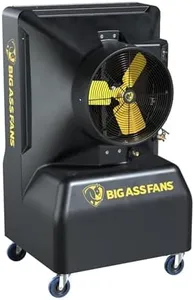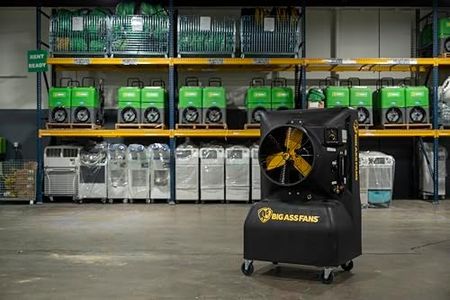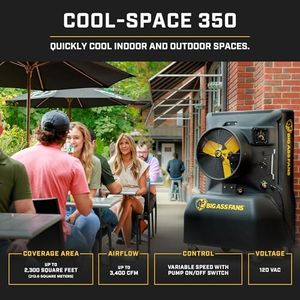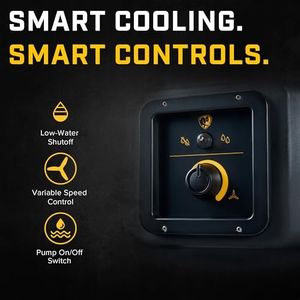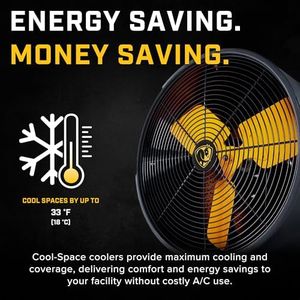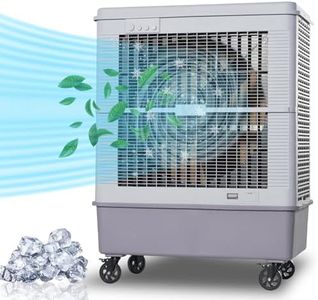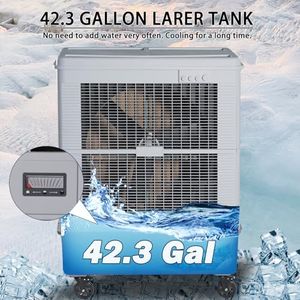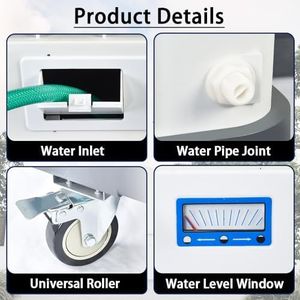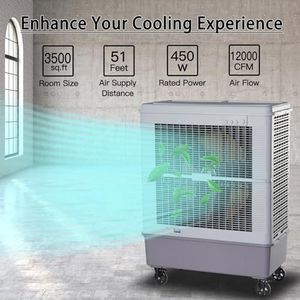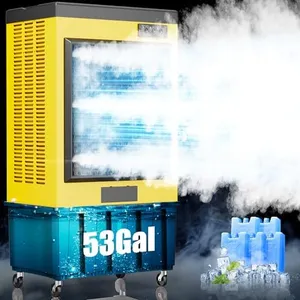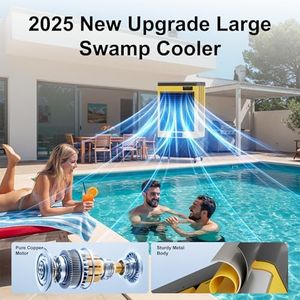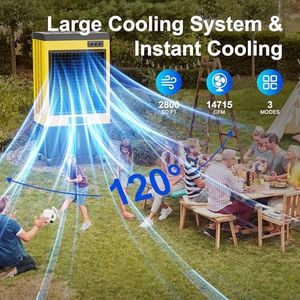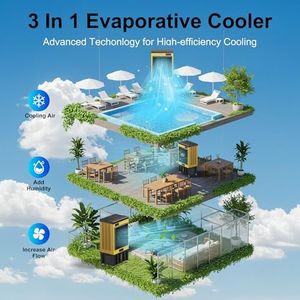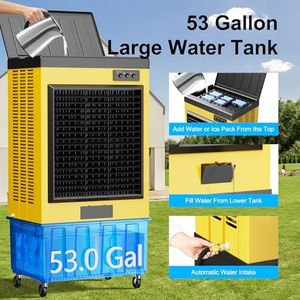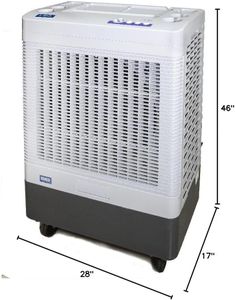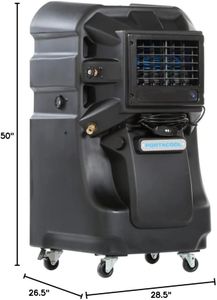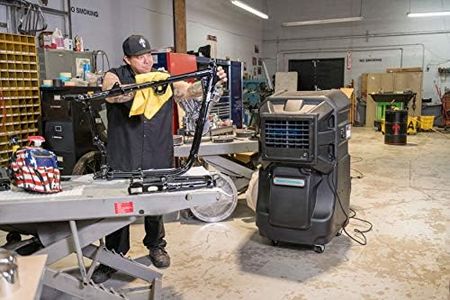10 Best Swamp Coolers 2025 in the United States
Winner
Portacool Apex 4000 (PACA40001A1) – Wi-Fi Enabled High Velocity Portable Evaporative Cooler for 4000 sq. ft. with up to 50-foot Reach, Programable, 55 Gallon Reservoir, Variable Speed
The Portacool Apex 4000 is a powerful evaporative cooler designed to cover large spaces up to 4000 square feet, making it a strong choice for warehouses, workshops, or large outdoor areas. Its 36-inch fan can send cool air up to 50 feet away, providing effective airflow across big rooms. The 55-gallon water reservoir is quite large, meaning it can run for long periods without needing a refill, which is convenient for continuous use. This model is Wi-Fi enabled with touchscreen and app controls, so you can adjust settings remotely, a handy feature that adds modern convenience.
Most important from
4 reviews
Portacool Apex 700 (PACA07001A1) – Wi-Fi Enabled High Velocity Portable Evaporative Cooler for 700 sq. ft. with up to 60-foot Reach, Oscillating Louvers, Programable, 22 Gallon Reservoir, Variable Spd
The Portacool Apex 700 is designed to cool spaces up to 700 square feet, making it a strong choice for commercial or industrial settings like gyms or workshops. Its high airflow of 1400 CFM and a 22-gallon water tank allow it to deliver a powerful, steady cooling breeze up to 60 feet away. The cooler’s noise level is reasonably low at 53 dB, which means it won’t be too disruptive in most environments. Mobility is decent given its 88-pound weight; it features a slim design with a built-in handle and wheels, letting you move it around fairly easily despite the size. The front intake and slim profile also help you place it close to walls to save space.
Most important from
5 reviews
Big Ass Fans - Cool-Space 400 - Portable Evaporative Swamp Cooler, 36 Inch Diameter Fan Indoor Outdoor Use Continuous or Fillable 46 Gallon Capacity Variable Speed – Cooling for Warehouses & Workshops
The Big Ass Fans Cool-Space 400 is a robust swamp cooler designed for large workspaces such as workshops, garages, and studios. It effectively cools areas up to 3,600 square feet with an impressive airflow ranging from 6,400 to 9,700 CFM, making it highly efficient in cooling sizable spaces. The cooler boasts a substantial 46-gallon water tank, allowing for up to 10 hours of continuous operation, which is ideal for long work shifts without frequent refilling.
Most important from
11 reviews
Top 10 Best Swamp Coolers 2025 in the United States
Winner
Portacool Apex 4000 (PACA40001A1) – Wi-Fi Enabled High Velocity Portable Evaporative Cooler for 4000 sq. ft. with up to 50-foot Reach, Programable, 55 Gallon Reservoir, Variable Speed
Portacool Apex 4000 (PACA40001A1) – Wi-Fi Enabled High Velocity Portable Evaporative Cooler for 4000 sq. ft. with up to 50-foot Reach, Programable, 55 Gallon Reservoir, Variable Speed
Chosen by 1473 this week
Portacool Apex 700 (PACA07001A1) – Wi-Fi Enabled High Velocity Portable Evaporative Cooler for 700 sq. ft. with up to 60-foot Reach, Oscillating Louvers, Programable, 22 Gallon Reservoir, Variable Spd
Portacool Apex 700 (PACA07001A1) – Wi-Fi Enabled High Velocity Portable Evaporative Cooler for 700 sq. ft. with up to 60-foot Reach, Oscillating Louvers, Programable, 22 Gallon Reservoir, Variable Spd
Big Ass Fans - Cool-Space 400 - Portable Evaporative Swamp Cooler, 36 Inch Diameter Fan Indoor Outdoor Use Continuous or Fillable 46 Gallon Capacity Variable Speed – Cooling for Warehouses & Workshops
Big Ass Fans - Cool-Space 400 - Portable Evaporative Swamp Cooler, 36 Inch Diameter Fan Indoor Outdoor Use Continuous or Fillable 46 Gallon Capacity Variable Speed – Cooling for Warehouses & Workshops
Portacool Apex 500 (PACA05001A1) – Wi-Fi Enabled High Velocity Portable Evaporative Cooler for 500 sq. ft. with up to 55-foot Reach, Oscillating Louvers, Programable, 13 Gallon Reservoir, Variable Spd
Portacool Apex 500 (PACA05001A1) – Wi-Fi Enabled High Velocity Portable Evaporative Cooler for 500 sq. ft. with up to 55-foot Reach, Oscillating Louvers, Programable, 13 Gallon Reservoir, Variable Spd
Portacool PACJS2701A1 Jetstream 270 Portable Evaporative Cooler, Black
Portacool PACJS2701A1 Jetstream 270 Portable Evaporative Cooler, Black
Big Ass Fans - Cool-Space 350 - Portable Evaporative Swamp Cooler, Indoor and Outdoor Use, 16 Gallon Capacity, Variable Speed for Ultimate Cooling in Workshops and Garages
Big Ass Fans - Cool-Space 350 - Portable Evaporative Swamp Cooler, Indoor and Outdoor Use, 16 Gallon Capacity, Variable Speed for Ultimate Cooling in Workshops and Garages
12000 CFM Evaporative Cooler 59", 160L- - 42.3 Gal Tank, 90°Oscillation, 450W 6 Speeds Swamp Water Cooler 120V, Industrial Strength Swamp Cooler for Outdoor Commercial Factories - Gray
12000 CFM Evaporative Cooler 59", 160L- - 42.3 Gal Tank, 90°Oscillation, 450W 6 Speeds Swamp Water Cooler 120V, Industrial Strength Swamp Cooler for Outdoor Commercial Factories - Gray
AKIRES 14715CFM Swamp Coolers,Evaporative Air Cooler for 2800Sq.ft of Space,with Continuous Auto Fill,53-Gal Water Tank,120°Oscillation,5 Ice Packs,Cooling Fan for Outdoor,Indoor Yellow(71IN)
AKIRES 14715CFM Swamp Coolers,Evaporative Air Cooler for 2800Sq.ft of Space,with Continuous Auto Fill,53-Gal Water Tank,120°Oscillation,5 Ice Packs,Cooling Fan for Outdoor,Indoor Yellow(71IN)
Hessaire MC61M 5,300 CFM 3-Speed Portable Evaporative Cooler
Hessaire MC61M 5,300 CFM 3-Speed Portable Evaporative Cooler
Portacool PACJS2301A1 Jetstream 230 Portable Evaporative Cooler, Black
Portacool PACJS2301A1 Jetstream 230 Portable Evaporative Cooler, Black
Our technology thoroughly searches through the online shopping world, reviewing hundreds of sites. We then process and analyze this information, updating in real-time to bring you the latest top-rated products. This way, you always get the best and most current options available.

